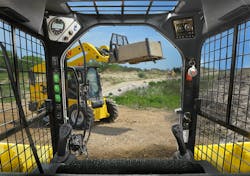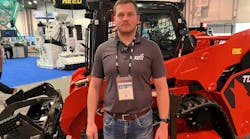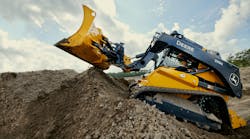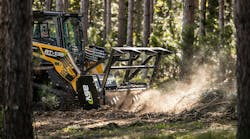Manufacturers of compact track loaders have moved toward closed-unit cabs in recent years, which not only improves visibility but also, and perhaps more importantly, improves operator safety.
Recent safety advancements include reducing frame obstructions, “cleaning up” control functions, and moving away from steel gridded mesh “screening” inside the cab to improve visibility out the side windows.
Read more about how compact track loader design aids safety.
“The original intent with that screening was so when you did not have a cab, the screen would keep you from sticking your arm or head out into that loader area,” says Buck Storlie, ASV’s product manager for compact track loaders. “You don’t want loader operation to interfere with operator safety.”
Because of this, some manufacturers have moved away from traditional steel screens and begun offering glass enclosures. ASV’s Max-Series, for example, offers CTLs with floor-to-ceiling tempered glass sides and frameless doors.
“This allows 360-degree visibility with minimal obstruction to the operator’s line of sight, providing a better view of surroundings and the bucket edge,” says Storlie.
According to Storlie, the glass cab provides the same level of protection between the operator and loader as previous steel screens. ASV tested the Max-Series cab for five years before release using strain gauging, vibration tests, extreme terrain tests, and more.
“Additionally, we offer an over-the-glass side screen option and reinforced polycarbonate door for those in extreme applications, such as brush cutting and demolition,” he says.
ASV also adopted a glued-in window design to remove obstructing bracketing, extra bolting, and hardware.
“By going to a glue-in glass panel without side screens, we were really able to grow that area to the sides,” says Storlie. “This allows operators to see the machine’s actual track or wheel from inside the cab. That way, it’s much easier to get up next to a building or object.”
Similarly, the Bobcat R series CTL offers polycarbonate panels as an option on its CTLs, while providing protection equivalent to a steel screen.
“Replacing that with glass removes 75 percent of the CTL’s steel screen and gives a great view to the side,” says Tyler Zima, loader product specialist, Bobcat. “It also has an abrasion-resistant coating on it, because polycarbonate can scratch.”
Caterpillar’s customer research indicated that the traditional square grid on the side steel side mesh obstructed operator views, according to Kevin Coleman, product specialist, Caterpillar.
“Our engineers developed what we call a ‘slanted mesh’ design instead of the square pattern found on traditional steel mesh side screens,” he says. “When you sit inside the machine and look out at that downward angle, you’ll notice the screen is slanted rather than squared to the ground. Since a CTL operator’s eyes naturally look downward on site, the slanted design better aligns with their line of sight, allowing them to look past that screen instead of ‘at’ it.”
Caterpillar also focused on delivering large roof windows with less metal gridding, providing increased visibility while working overhead.
“With CTLs, operators will often perform material handling and truck loading,” says Coleman. “Because of that, gaining visibility out the top of the CTL is important. The window has a protective mesh screen there, but operators want as much open area as possible.”
Coleman says it is imperative that operators are able to easily glance through the top window to see their bucket.
“If you’re truck loading, you have to make sure the bucket is going to clear the side of the truck,” he says. “We also made sure the window is located where operators don’t have to lean forward, back, or work hard in order to see.”
Manufacturers have also focused on the body of the machine. ASV engineers found that the front of the loader was one area that inhibited visibility, according to Storlie.
“You have to have a cross structure in the front in order to provide the support and strength that the loader requires,” he says. “But moving it a little bit here and there can have a big impact.”
To combat this, ASV lowered its front cross member, taking it farther out of the operator’s line of sight.
“The higher it is, the more it’s blocking the back edge of the bucket,” Storlie says. “By dropping it lower, we’re able to improve [sight to] the back edge of the bucket and also move it closer to the cab, which kind of does the same thing: If you pull it closer to the operator it’s easier to peer over the top.”
ASV also adjusted the rear pillar in the back of the cab, moving it out of the operator’s line of sight when in reverse.
“The rear pillars of the cabin used to be all the way in the back, and the window would bolt to that,” he says. “One of the things we found is that those rear pillars are right in the operator’s line of sight when you turn your head to look as you back up.”
By moving the pillars forward, engineers expanded the visibility plane between them.
“We slid the pillars slightly forward and went to a three-panel rear, so instead of the very back corners being steel pillars, it’s actually glass,” he says. “If you’re sitting and doing a 360 axis, the closer you get the pillars to that axis, the less it actually blocks where you’re trying to go.”
At Bobcat, engineers discontinued the use of bulky, fabricated steel on its R Series front lift arms. Instead, the CTL features slimmer steel castings.
“The whole lift arm isn’t a casting, but the front portion is, which provides better durability,” says Zima. “They’re also slimmer and don’t use as much plated steel. The slimmer design has optimized views, especially to the corners of a bucket or attachment.”
The company also shortened the driver link, which stabilizes the lift arm. On previous models, the CTL driver link was placed all the way to the front of the lift arm; Bobcat moved it behind the operator.
“When your bucket is in the down position, it’s not really that noticeable,” Zima says. “But when you start getting to eye level, dump truck height, the link can be seen. So with this change, the link would be farther out of view to both the left and right sides when your lift arms are raised.”
The machine’s H-link has also been updated.
“The H-link has gotten smaller and slimmer on the vertical lift machines,” Zima says. “So when you’re looking out the rear of the machine, you have a little more visibility because that went to cast steel as well. Without having all the [fabricated] metal, we were able to make that slimmer and enhance visibility.”
Caterpillar also updated its CTL arm design. Similarly, engineers moved from a bulkier fabricated arm design to adopting a more compact, “tubular” design.
“The tubular design not only gives the strength that you want, but also gives a smaller profile and a lower cross section for better sight lines,” says Coleman. “A big fabricated design where you have slabs of steel welded together creates a much bigger box, or profile, if you will. We know that obstructs some operator visibility because we used to have a design like that.”
Takeuchi also redesigned its 2 Series track loaders with visibility in mind. The machine’s front arm assembly cross member was lowered on these models and brought in closer to the machine for added visibility, according to Lee Padgett, CTL product manager.
“It also features a see-through step design that offers much more visibility to the cutting edge, and quick-attach locking levers that make coupling attachments simple,” he says.
Although it might not be intuitive, poor visibility can also contribute to fatigue over the course of a day.
“When an operator has to lean forward to see the cutting edge or strain to look over their shoulders to see to the side and rear, it stresses their back and neck,” says Adam Devins, Wacker Neuson product manager, skid steers. “Our team focused on constructing larger doors, large side windows, and a rear hood that tapers quickly downward to combat this.”
The cab forward design also moves the operator closer to attachments for a better vantage point, he says, enabling them to see both the leading and cutting edges.
On Case’s B Series, engineers focused on a narrow pillar design that encourages better visibility while still meeting ROPS requirements. In addition, several operational switches have migrated from inside the cab to within the machine’s display screen.
Rather than flipping physical switches and knobs, an operator now uses buttons on the monitor to set functions like bucket, lift arm, and machine speed.
“There is no longer the need to have many switches inside the cab anymore,” says George MacIntyre, skid steers CTL product manager for Case. “The display screen allows us to reserve most functionality for one spot and allows us to have the best visibility as possible, because we don’t have switches in different places all over.”
Even with these functions moving into the monitor, MacIntyre says main switches (hydraulic modes, heating, air) remain on the machine’s narrowed front pillars without impacting visibility. The machine’s exterior lights, for example, are located on the left hand pillar.
“The pillars allow us to put the main switches at a visual line of sight for the operator,” MacIntyre says. “It’s important to have those visible for operators. We need the posts anyway for structural reasons, and we don’t want to hide any switches that are important for their daily functions.”





